6.2: Gram Staining Procedure
- Page ID
- 123358
\( \newcommand{\vecs}[1]{\overset { \scriptstyle \rightharpoonup} {\mathbf{#1}} } \)
\( \newcommand{\vecd}[1]{\overset{-\!-\!\rightharpoonup}{\vphantom{a}\smash {#1}}} \)
\( \newcommand{\id}{\mathrm{id}}\) \( \newcommand{\Span}{\mathrm{span}}\)
( \newcommand{\kernel}{\mathrm{null}\,}\) \( \newcommand{\range}{\mathrm{range}\,}\)
\( \newcommand{\RealPart}{\mathrm{Re}}\) \( \newcommand{\ImaginaryPart}{\mathrm{Im}}\)
\( \newcommand{\Argument}{\mathrm{Arg}}\) \( \newcommand{\norm}[1]{\| #1 \|}\)
\( \newcommand{\inner}[2]{\langle #1, #2 \rangle}\)
\( \newcommand{\Span}{\mathrm{span}}\)
\( \newcommand{\id}{\mathrm{id}}\)
\( \newcommand{\Span}{\mathrm{span}}\)
\( \newcommand{\kernel}{\mathrm{null}\,}\)
\( \newcommand{\range}{\mathrm{range}\,}\)
\( \newcommand{\RealPart}{\mathrm{Re}}\)
\( \newcommand{\ImaginaryPart}{\mathrm{Im}}\)
\( \newcommand{\Argument}{\mathrm{Arg}}\)
\( \newcommand{\norm}[1]{\| #1 \|}\)
\( \newcommand{\inner}[2]{\langle #1, #2 \rangle}\)
\( \newcommand{\Span}{\mathrm{span}}\) \( \newcommand{\AA}{\unicode[.8,0]{x212B}}\)
\( \newcommand{\vectorA}[1]{\vec{#1}} % arrow\)
\( \newcommand{\vectorAt}[1]{\vec{\text{#1}}} % arrow\)
\( \newcommand{\vectorB}[1]{\overset { \scriptstyle \rightharpoonup} {\mathbf{#1}} } \)
\( \newcommand{\vectorC}[1]{\textbf{#1}} \)
\( \newcommand{\vectorD}[1]{\overrightarrow{#1}} \)
\( \newcommand{\vectorDt}[1]{\overrightarrow{\text{#1}}} \)
\( \newcommand{\vectE}[1]{\overset{-\!-\!\rightharpoonup}{\vphantom{a}\smash{\mathbf {#1}}}} \)
\( \newcommand{\vecs}[1]{\overset { \scriptstyle \rightharpoonup} {\mathbf{#1}} } \)
\( \newcommand{\vecd}[1]{\overset{-\!-\!\rightharpoonup}{\vphantom{a}\smash {#1}}} \)
\(\newcommand{\avec}{\mathbf a}\) \(\newcommand{\bvec}{\mathbf b}\) \(\newcommand{\cvec}{\mathbf c}\) \(\newcommand{\dvec}{\mathbf d}\) \(\newcommand{\dtil}{\widetilde{\mathbf d}}\) \(\newcommand{\evec}{\mathbf e}\) \(\newcommand{\fvec}{\mathbf f}\) \(\newcommand{\nvec}{\mathbf n}\) \(\newcommand{\pvec}{\mathbf p}\) \(\newcommand{\qvec}{\mathbf q}\) \(\newcommand{\svec}{\mathbf s}\) \(\newcommand{\tvec}{\mathbf t}\) \(\newcommand{\uvec}{\mathbf u}\) \(\newcommand{\vvec}{\mathbf v}\) \(\newcommand{\wvec}{\mathbf w}\) \(\newcommand{\xvec}{\mathbf x}\) \(\newcommand{\yvec}{\mathbf y}\) \(\newcommand{\zvec}{\mathbf z}\) \(\newcommand{\rvec}{\mathbf r}\) \(\newcommand{\mvec}{\mathbf m}\) \(\newcommand{\zerovec}{\mathbf 0}\) \(\newcommand{\onevec}{\mathbf 1}\) \(\newcommand{\real}{\mathbb R}\) \(\newcommand{\twovec}[2]{\left[\begin{array}{r}#1 \\ #2 \end{array}\right]}\) \(\newcommand{\ctwovec}[2]{\left[\begin{array}{c}#1 \\ #2 \end{array}\right]}\) \(\newcommand{\threevec}[3]{\left[\begin{array}{r}#1 \\ #2 \\ #3 \end{array}\right]}\) \(\newcommand{\cthreevec}[3]{\left[\begin{array}{c}#1 \\ #2 \\ #3 \end{array}\right]}\) \(\newcommand{\fourvec}[4]{\left[\begin{array}{r}#1 \\ #2 \\ #3 \\ #4 \end{array}\right]}\) \(\newcommand{\cfourvec}[4]{\left[\begin{array}{c}#1 \\ #2 \\ #3 \\ #4 \end{array}\right]}\) \(\newcommand{\fivevec}[5]{\left[\begin{array}{r}#1 \\ #2 \\ #3 \\ #4 \\ #5 \\ \end{array}\right]}\) \(\newcommand{\cfivevec}[5]{\left[\begin{array}{c}#1 \\ #2 \\ #3 \\ #4 \\ #5 \\ \end{array}\right]}\) \(\newcommand{\mattwo}[4]{\left[\begin{array}{rr}#1 \amp #2 \\ #3 \amp #4 \\ \end{array}\right]}\) \(\newcommand{\laspan}[1]{\text{Span}\{#1\}}\) \(\newcommand{\bcal}{\cal B}\) \(\newcommand{\ccal}{\cal C}\) \(\newcommand{\scal}{\cal S}\) \(\newcommand{\wcal}{\cal W}\) \(\newcommand{\ecal}{\cal E}\) \(\newcommand{\coords}[2]{\left\{#1\right\}_{#2}}\) \(\newcommand{\gray}[1]{\color{gray}{#1}}\) \(\newcommand{\lgray}[1]{\color{lightgray}{#1}}\) \(\newcommand{\rank}{\operatorname{rank}}\) \(\newcommand{\row}{\text{Row}}\) \(\newcommand{\col}{\text{Col}}\) \(\renewcommand{\row}{\text{Row}}\) \(\newcommand{\nul}{\text{Nul}}\) \(\newcommand{\var}{\text{Var}}\) \(\newcommand{\corr}{\text{corr}}\) \(\newcommand{\len}[1]{\left|#1\right|}\) \(\newcommand{\bbar}{\overline{\bvec}}\) \(\newcommand{\bhat}{\widehat{\bvec}}\) \(\newcommand{\bperp}{\bvec^\perp}\) \(\newcommand{\xhat}{\widehat{\xvec}}\) \(\newcommand{\vhat}{\widehat{\vvec}}\) \(\newcommand{\uhat}{\widehat{\uvec}}\) \(\newcommand{\what}{\widehat{\wvec}}\) \(\newcommand{\Sighat}{\widehat{\Sigma}}\) \(\newcommand{\lt}{<}\) \(\newcommand{\gt}{>}\) \(\newcommand{\amp}{&}\) \(\definecolor{fillinmathshade}{gray}{0.9}\)The Gram staining procedure involves four basic steps:
1. The bacteria are first stained with the basic dye crystal violet. Both Gram-positive and Gram-negative bacteria become directly stained and appear purple after this step.
2. The bacteria are then treated with Gram's iodine solution. This allows the stain to be retained better by forming an insoluble crystal violet-iodine complex. Both Gram-positive and Gram-negative bacteria remain purple after this step.
3. Gram's decolorizer, a mixture of ethyl alcohol and acetone, is then added. This is the differential step. Gram-positive bacteria retain the crystal violet-iodine complex while Gram-negative are decolorized.
4. Finally, the counterstain safranin (also a basic dye) is applied. Since the Gram-positive bacteria are already stained purple, they are not affected by the counterstain. Gram-negative bacteria, which are now colorless, become directly stained by th e safranin. Thus, Gram-positive appear purple, and Gram-negative appear pink.
|
Fig. \(\PageIndex{1A}\) : Gram Stain of Staphylococcus epidermidis |
Fig. \(\PageIndex{1B}\): Gram Stain of Escherichia coli |
|---|---|
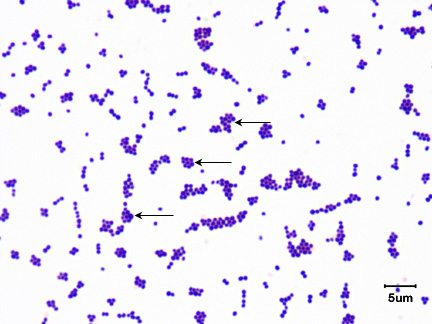 |
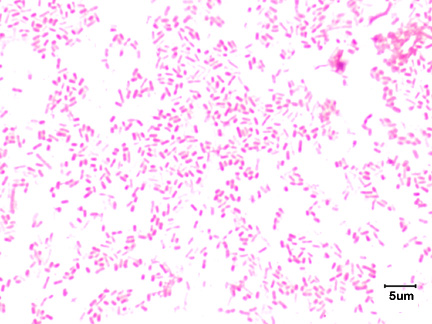 |
| Note Gram-positive (purple) cocci in irregular clusters. | Note Gram-negative (pink) bacilli. |
| (Copyright; Gary E. Kaiser, Ph.D. The Community College of Baltimore County, Catonsville Campus CC-BY-3.0) | |
With the current theory behind Gram staining, it is thought that in Gram-positive bacteria, the crystal violet and iodine combine to form a larger molecule that precipitates out within the cell. The alcohol/acetone mixture then causes dehydration of the multilayered peptidoglycan, thus decreasing the space between the molecules and causing the cell wall to trap the crystal violet-iodine complex within the cell. In the case of Gram-negative bacteria, the alcohol/acetone mixture, being a lipid solvent, dissolves the outer membrane of the cell wall and may also damage the cytoplasmic membrane to which the peptidoglycan is attached. The few layers of peptidoglycan are unable to retain the crystal violet-iodine complex and the cell is decolorized.
It is important to note that Gram-positivity (the ability to retain the purple crystal violet-iodine complex) is not an all-or-nothing phenomenon but a matter of degree. There are several factors that could result in a Gram-positive organism staining Gram-negatively:
1. The method and techniques used. Overheating during heat fixation, over decolorization with alcohol, and even too much washing with water between steps may result in Gram-positive bacteria losing the crystal violet-iodine complex.
2. The age of the culture. Cultures more than 24 hours old may lose their ability to retain the crystal violet-iodine complex.
3. The organism itself. Some Gram-positive bacteria are more able to retain the crystal violet-iodine complex than others.
Therefore, one must use very precise techniques in Gram staining and interpret the results with discretion.
Trypticase Soy agar plate cultures of Escherichia coli (a small, Gram-negative bacillus) and Staphylococcus epidermidis (a Gram-positive coccus with a staphylococcus arrangement).
PROCEDURE (to be done individually)
1. Make a Gram stain of Escherichia coli
a. Fix a smear of Escherichia coli to the slide as follows:
1. First place a small piece of tape at one end of the slide and label it with the name of the bacterium you will be placing on that slide .
2. Sterilize your inoculating loop and place one loop full of deionized water from your dropper bottle on your slide. (See Fig. \(\PageIndex{2}\) 1, Step 1, Step 2, and Step 3.)
|
Fig. \(\PageIndex{2}\) Step 1: Remove a Loopfull of Deionized Water |
Fig. \(\PageIndex{2}\) Step 2: Place the Loopfull of Water on the Slide |
Fig. \(\PageIndex{2}\) Step 3: Correct Amount of Water on the Slide |
|---|---|---|
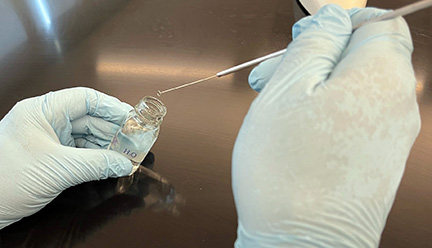 |
 |
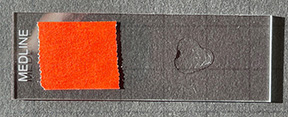 |
| Using your sterilized inoculating loop, remove one loopfull of water from your bottle of deionized water.g a vortex mixer, mix the contents of the tube. | Place the loopfull of water on your slide. | A loopfull of deionized water on your slide. |
| (Copyright; Gary E. Kaiser, Ph.D. The Community College of Baltimore County, Catonsville Campus CC-BY-3.0) | ||
3. Using the edge of your sterile inoculating loop, aseptically remove a small amount of the culture from the agar surface (see Fig. \(\PageIndex{3}\) , Step 1) and gently touch it several times to the drop of water until the water becomes visibly cloudy (see Fig. \(\PageIndex{3}\) , Step 2 and Fig. \(\PageIndex{3}\) , Step 3.)
|
Fig. \(\PageIndex{3}\) Step 1: Using the Edge of the Loop, Remove Bacteria from the Petri Plate |
Fig. \(\PageIndex{3}\) Step 2: Add Small Amount of Bacteria to the Water |
Fig. \(\PageIndex{3}\) Step 3: Correct Amount of Bacteria Added to the Water |
 |
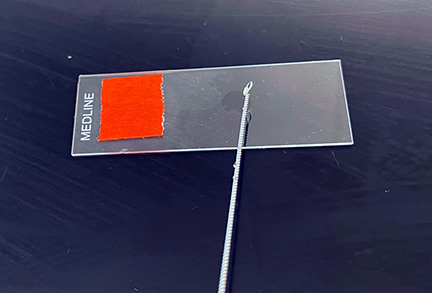 |
 |
| Using the edge of your sterilized inoculating loop, remove a small amount of bacteria from the petri plate. | Repeatedly touch the edge of the inoculating loop until the water just turns cloudy. Be carefull not to add too much bacteria. | This is the correct amount of bacteria to add to the water for a good bacterial smear. |
| (Copyright; Gary E. Kaiser, Ph.D. The Community College of Baltimore County, Catonsville Campus CC-BY-3.0) | ||
4. Incinerate the remaining bacteria on the inoculating loop. If too much culture is added to the water, you will not see stained individual bacteria.
5. After the inoculating loop cools, spread the suspension over the slide to form a thin film. (See Fig. \(\PageIndex{4}\).)
6. Allow this thin suspension to completely air dry (see Fig. \(\PageIndex{5}\)). The smear must be completely dry before the slide is fixed!
7. If your professor instructs you to heat-fix the bacteria to the slide, pick up the air-dried slide with provided close pin and hold the bottom of the slide opposite the smear against the opening of the bacto-incinerator for 10 seconds (see Fig. \(\PageIndex{6}\)). If the slide is not heated enough, the bacteria will be washed off the slide. If it is overheated, the bacteria structural integrity can be damaged.

Figure \(\PageIndex{6}\): Heat Fixing a Slide. To heat-fix the bacteria to the slide, pick up the air-dried slide with coverslip forceps and hold the bottom of the slide opposite the smear near the opening of the bacto-incinerator for 10 seconds. (Copyright; Gary E. Kaiser, Ph.D. The Community College of Baltimore County, Catonsville Campus CC-BY-3.0)
8. If your professor instructs you to fix the bacteria to the slide using methanol, add 2-3 drops of 95% methanol to the air-dried smear of bacteria (see Fig. \(\PageIndex{7}\)) and let sit for 2 minutes or until the methanol evaporates. Let the slide again air dry before staining.

b. Stain with Hucker's crystal violet for one minute (Figure \(\PageIndex{8}\)). Gently wash with water (Figure \(\PageIndex{9}\)). Shake off the excess water but do not blot dry between steps.
Fig. \(\PageIndex{8}\) : Gram Stain: Staining with Crystal Violet |
Fig. \(\PageIndex{9}\): Gram Stain: Washing with Water |
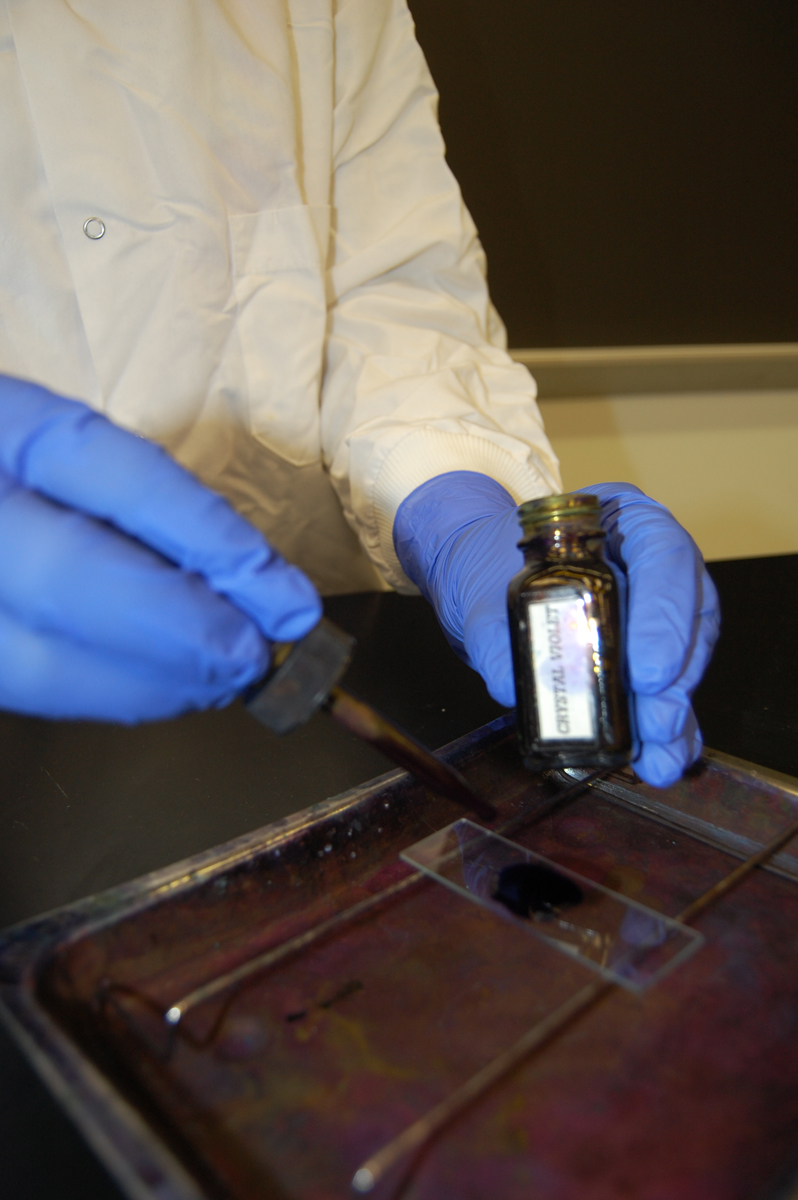 |
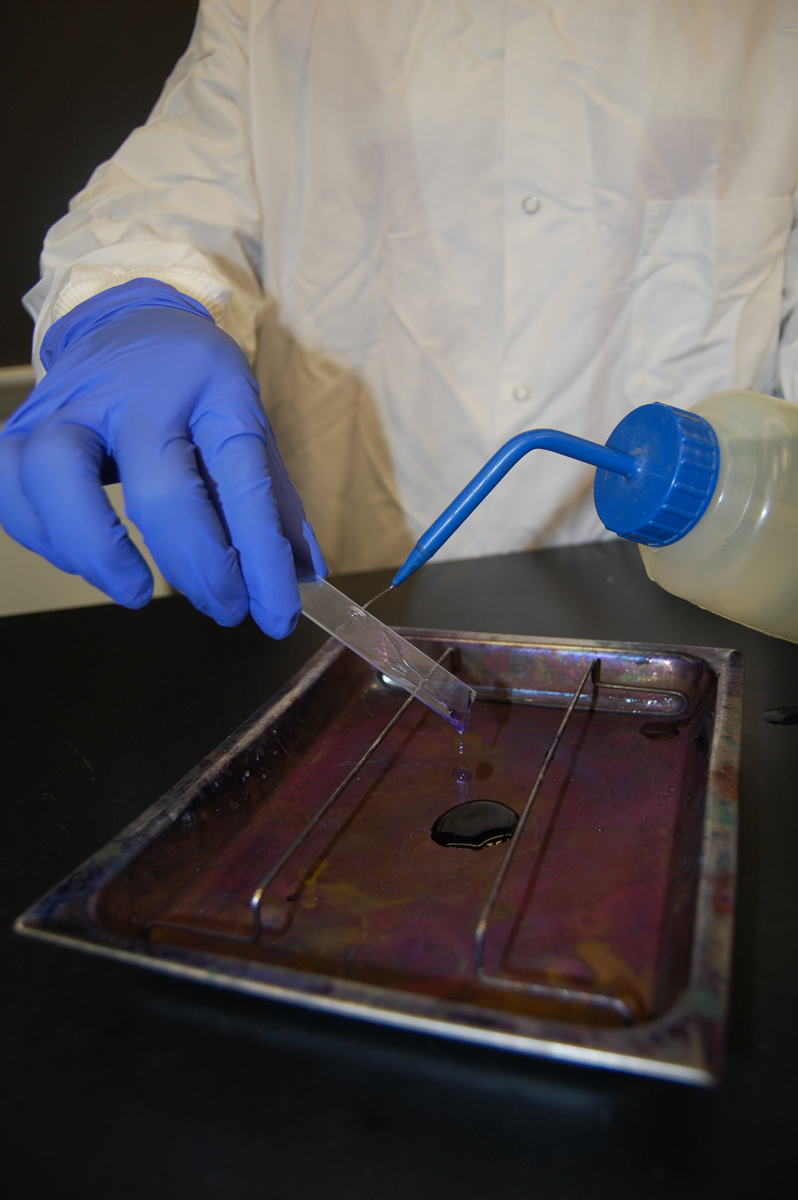 |
| Stain with Hucker's crystal violet for one minute. | Use your water bottle to gently wash off the excess stain. Shake off the excess water but do not blot dry between steps. |
| (Copyright; Gary E. Kaiser, Ph.D. The Community College of Baltimore County, Catonsville Campus CC-BY-3.0) | |
c. Stain with Gram's iodine solution for one minute (Figure \(\PageIndex{10}\)) and gently wash with water.

d. Decolorize by picking up the slide and letting the Gram's decolorizer run down the slide until the purple just stops flowing at the bottom of the slide (Figure \(\PageIndex{11}\)).

- Make sure the entire smear is evenly decolorized and that you are not under-decolorizing or over-decolorizing.
- Wash immediately with water.
e. Stain with safranin for one minute (Figure \(\PageIndex{12}\)). When you wash off the excess safranin, be very careful to wash gently and briefly as it is possible to wash out some of the sarfanin in the bacterium.

f. Blot dry (Figure \(\PageIndex{13}\): and observe using oil immersion microscopy.

2. Using the same procedure described above, make a second Gram stain of Staphylococcus aureus.
3. Make sure you carefully pour the used dye down the designated drains at the three lab benches, not down the sink.
Many bacteria secrete a slimy, viscous covering called a capsule or glycocalyx . This is usually composed of polysaccharide, polypeptide, or both.

The ability to produce a capsule is an inherited property of the organism, but the capsule is not an absolutely essential cellular component. Capsules are often produced only under specific growth conditions. Even though not essential for life, capsules p robably help bacteria to survive in nature. Capsules help many pathogenic and normal flora bacteria to initially resist phagocytosis by the host's phagocytic cells. In soil and water, capsules help prevent bacteria from being engulfed by protozoans. Capsules also help many bacteria to adhere to surfaces and thus resist flushing. It also enables many bacteria to form biofilms. A biofilm consists layers of bacterial populations adhering to host cells and embedded in a common capsular mass.
For further information on the bacterial capsules, see the following Learning Objects in your Lecture Guide:
- The Glycocalyx (Capsule) and S-Layer; Unit 1, Section IIB4a
- The Ability to Resist Phagocytic Engulfment; Unit 3, Section B5b
Skim Milk broth culture of Enterobacter aerogenes. The skim milk supplies essential nutrients for capsule production and also provides a slightly stainable background.
PROCEDURE (to be done individually)
1. Stir up the Skim Milk broth culture with your loop and place 2-3 loops of Enterobacter aerogenes on a microscope slide.
2. Using your inoculating loop, spread the sample out to cover about one inch of the slide.
3. Let it completely air dry. Do not heat fix. Capsules stick well to glass, and heat may destroy the capsule.
4. Stain with crystal violet for one minute.
5. Wash off the excess dye with 20% copper sulfate solution.
6. Shake off the excess copper sulfate solution and immediately blot dry.
7. Observe using oil immersion microscopy. The organism and the milk dried on the slide will pick up the purple dye while the capsule will remain colorless.
8. Make sure you carefully pour the used dye in your staining tray into the waste dye collection container, not down the sink.
9. Observe the demonstration capsule stain of Streptococcus lactis , an encapsulated bacterium that is normal flora in milk. See Fig. \(\PageIndex{17}\).

Make drawings of each bacterium on your Gram stain preparation.
| Color = Gram reaction = Shape = |
Color = Gram reaction = Shape = Arrangement = |
Contributors and Attributions
Dr. Gary Kaiser (COMMUNITY COLLEGE OF BALTIMORE COUNTY, CATONSVILLE CAMPUS)



